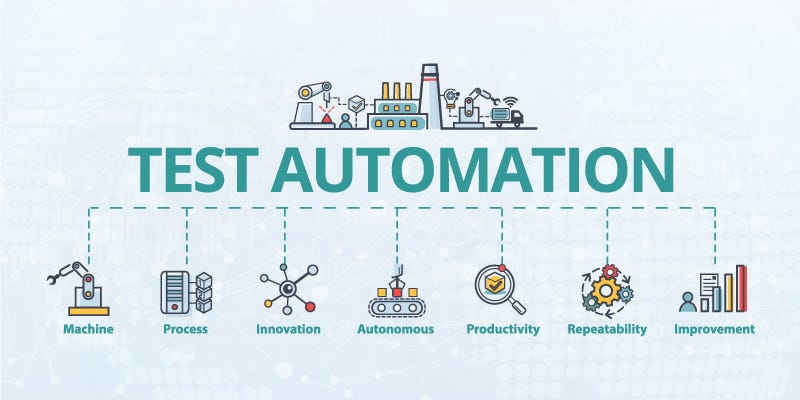Picking the Right Equipment for Effective Automation Testing Solutions
Picking the Right Equipment for Effective Automation Testing Solutions
Blog Article
From Guidebook to Automated Testing: A Comprehensive Overview to Transitioning Smoothly and Effectively
In the world of software program screening, the shift from handbook to automated processes has actually come to be an increasingly vital transition for companies looking for to improve performance and precision in their testing practices. As innovation remains to breakthrough, the demand for seamless and efficient automated testing methods has never been more pressing. The trip from handbook to automated testing is not without its challenges, however when approached purposefully and with a clear strategy in mind, the advantages can be considerable - automation testing. In this extensive guide, we will check out vital steps and factors to consider important for an effective change, from the initial selection of tools to the integration of automation into existing workflows. Stay tuned to uncover the understandings that will certainly aid lead the way for a smoother and much more efficient testing procedure.
Benefits of Automated Examining
Automated testing offers various benefits, improving efficiency and accuracy in software program development procedures. Automated tests can be run simultaneously on numerous devices and operating systems, considerably speeding up the screening phase compared to hand-operated screening.
In addition, automated screening makes certain a greater level of accuracy in discovering issues. Uniformity in screening is also improved, as automated tests execute the same actions precisely each time they are run.
Selecting the Right Devices

Firstly, examine your objectives and demands. Understand the scope of your job, the innovations entailed, and the capability of your group. This evaluation will help you identify the features and abilities you require in your screening tools.
Secondly, consider the compatibility of the tools with your existing procedures and systems. Seamless integration with your existing software growth lifecycle is necessary to make sure a smooth shift to automation.
Furthermore, examine the scalability and adaptability of the devices. As your testing needs advance, the tools ought to have the ability to adjust and fit modifications successfully.
Last but not least, variable in the support and neighborhood around the devices. When implementing automated testing, durable support and an active user area can supply useful resources and assistance. By very carefully thinking about these facets, you can pick the right tools that line up with your requirements and established the stage for a successful transition to automated testing.
Composing Reliable Test Manuscripts

When crafting test scripts, it is necessary to consider the details demands of the software being examined and ensure that the manuscripts address all critical functionalities. Descriptive and clear naming conventions for visit this page test scripts and examination situations can boost readability and maintainability. Furthermore, integrating error handling systems within the test scripts can assist in determining and dealing with concerns immediately.
In addition, organizing examination scripts into modular components can boost reusability and scalability, decreasing redundancy and boosting performance in examination script maintenance. Normal evaluations and updates to test manuscripts are essential to equal developing software program demands and functionalities. By following these principles, testers can produce durable and efficient examination scripts that add significantly to the success of automated screening procedures.
Integrating Automation Into Workflows
By effortlessly integrating automated screening tools like Selenium or Appium right into the software application advancement lifecycle, teams can achieve faster feedback on code adjustments, leading to quicker insect detection and resolution. This combination allows for constant screening throughout the growth procedure, guaranteeing that any problems are determined early on, resulting in greater software application high quality. Correct integration of automation devices calls for cooperation between development, screening, and operations teams to establish a unified workflow that maximizes efficiency and effectiveness in providing high-quality software application items.
Ensuring a Smooth Transition
Efficiently transitioning to automated screening involves meticulous preparation and careful execution to decrease interruptions and take full advantage of effectiveness in the software program growth process - automation testing. To make sure a smooth change, it is necessary to begin by conducting a detailed evaluation of the current testing procedures and determining locations where automation can bring one of the informative post most considerable advantages. Involving with all stakeholders beforehand in the process, including developers, testers, and task managers, is important for amassing support and buy-in for the automation initiative
Communication is crucial during this shift stage. Clear communication of the goals, advantages, and assumptions of automated testing assists to manage any type of resistance or worries that may emerge. Furthermore, offering ample training and resources for staff member to upskill in automation tools and methods is important for ensuring a successful transition.

Final Thought
To conclude, transitioning from handbook to automated screening uses many benefits, including increased efficiency and reliability. By picking the proper devices, composing effective test manuscripts, and integrating automation flawlessly into workflows, organizations can guarantee a smooth and effective transition. It is necessary to accept automation as a valuable possession in software screening processes to enhance general quality and efficiency.
In the world of software application testing, the change from manual to automated procedures has become an increasingly crucial shift for organizations seeking to improve efficiency and precision in their testing practices. Automated tests can be run concurrently on numerous devices and operating systems, dramatically speeding up the testing phase contrasted to manual testing. Consistency in testing is also enhanced, as automated examinations carry out the exact same actions precisely each time they are run.To ensure the successful execution of chosen testing tools, the creation of reliable test scripts plays an essential duty in validating the performance and performance of automated procedures - automation testing. By complying with these concepts, testers can produce robust and efficient test scripts that add significantly to the success of automated go to my blog testing procedures
Report this page